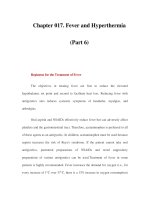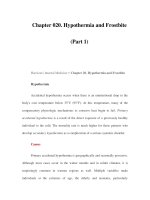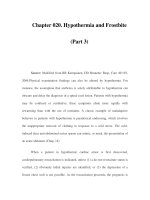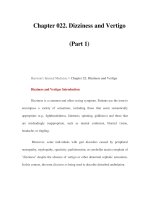Chapter 022. Dizziness and Vertigo (Part 1) doc
Bạn đang xem bản rút gọn của tài liệu. Xem và tải ngay bản đầy đủ của tài liệu tại đây (13.11 KB, 5 trang )
Chapter 022. Dizziness and Vertigo
(Part 1)
Harrison's Internal Medicine > Chapter 22. Dizziness and Vertigo
Dizziness and Vertigo: Introduction
Dizziness is a common and often vexing symptom. Patients use the term to
encompass a variety of sensations, including those that seem semantically
appropriate (e.g., lightheadedness, faintness, spinning, giddiness) and those that
are misleadingly inappropriate, such as mental confusion, blurred vision,
headache, or tingling.
Moreover, some individuals with gait disorders caused by peripheral
neuropathy, myelopathy, spasticity, parkinsonism, or cerebellar ataxia complain of
"dizziness" despite the absence of vertigo or other abnormal cephalic sensations.
In this context, the term dizziness is being used to describe disturbed ambulation.
There may be mild associated lightheadedness, particularly with impaired
sensation from the feet or poor vision; this is known as multiple-sensory-defect
dizziness and occurs in elderly individuals who complain of dizziness only when
walking. Decreased position sense (secondary to neuropathy or myelopathy) and
poor vision (from cataracts or retinal degeneration) create an overreliance on the
aging vestibular apparatus.
A less precise but sometimes comforting designation to patients is benign
dysequilibrium of aging. Thus, a careful history is necessary to determine exactly
what a patient who states, "Doctor, I'm dizzy," is experiencing.
After eliminating the misleading symptoms or gait disturbance, "dizziness"
usually means either faintness (presyncope) or vertigo (an illusory or hallucinatory
sense of movement of the body or environment, most often a feeling of spinning).
Operationally, after obtaining the history, dizziness may be classified into three
categories: (1) faintness, (2) vertigo, and (3) miscellaneous head sensations.
Faintness
Prior to an actual faint (syncope), there are often prodromal presyncopal
symptoms (faintness) reflecting ischemia to a degree insufficient to impair
consciousness. These include lightheadedness, "dizziness" without true vertigo, a
feeling of warmth, diaphoresis, nausea, and visual blurring occasionally
proceeding to blindness.
Presyncopal symptoms vary in duration and may increase in severity until
loss of consciousness occurs or may resolve prior to loss of consciousness if the
cerebral ischemia is corrected. Faintness and syncope are discussed in detail in
Chap. 21.
Vertigo
Vertigo is usually due to a disturbance in the vestibular system. The end
organs of this system, situated in the bony labyrinths of the inner ears, consist of
the three semicircular canals and the otolithic apparatus (utricle and saccule) on
each side.
The canals transduce angular acceleration, while the otoliths transduce
linear acceleration and the static gravitational forces that provide a sense of head
position in space.
The neural output of the end organs is conveyed to the vestibular nuclei in
the brainstem via the eighth cranial nerves. The principal projections from the
vestibular nuclei are to the nuclei of cranial nerves III, IV, and VI; spinal cord;
cerebral cortex; and cerebellum.
The vestibuloocular reflex (VOR) serves to maintain visual stability during
head movement and depends on direct projections from the vestibular nuclei to the
sixth cranial nerve (abducens) nuclei in the pons and, via the medial longitudinal
fasciculus, to the third (oculomotor) and fourth (trochlear) cranial nerve nuclei in
the midbrain.
These connections account for the nystagmus (to-and-fro oscillation of the
eyes) that is an almost invariable accompaniment of vestibular dysfunction. The
vestibular nerves and nuclei project to areas of the cerebellum (primarily the
flocculus and nodulus) that modulate the VOR.
The vestibulospinal pathways assist in the maintenance of postural stability.
Projections to the cerebral cortex, via the thalamus, provide conscious awareness
of head position and movement.
The vestibular system is one of three sensory systems subserving spatial
orientation and posture; the other two are the visual system (retina to occipital
cortex) and the somatosensory system that conveys peripheral information from
skin, joint, and muscle receptors.
The three stabilizing systems overlap sufficiently to compensate (partially
or completely) for each other's deficiencies. Vertigo may represent either
physiologic stimulation or pathologic dysfunction in any of the three sensory
systems.









